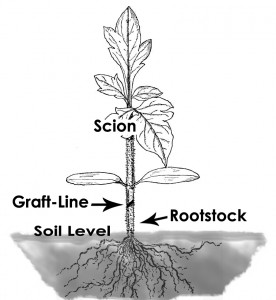Some of the tastiest tomatoes on the market just don’t thrive in our backyard gardens. Perhaps the soil is too compact or they succumb to various diseases. In many cases the roots of the fancier types just aren’t as vigorous as they are on the old standbys. Then there are the heirlooms that, while they may grow well, have smaller yields than some of the modern hybrids. Peppers and egg plants can be difficult to grow in our area (zone 5) because our growing season is just a bit too short for some of the larger varieties and often our summers are a bit too cold.
What if you could have the advantages of a hardy, disease resistant root stock with an excellent, large fruiting variety of tomato, pepper or eggplant? The producers of vegetable plants have taken notice of what rose growers have been doing for many years. They have begun grafting hardy rootstocks to plants that have more desirable types of fruit. This results in a more abundant crop of excellent fruit combined with a hardiness and disease resistance that is not associated with the original stock.
We found grafted vegetable this year at Totally Tomatoes (www.totallytomato.com) where you can get tomatoes, peppers and eggplant. Henry Fields (www.henryfields.com) and Burpee (www.burpee.com) both have a few peppers and tomatoes. Grafting can also be done with watermelon and other melons but they are difficult to find in the U.S. It is more common in Japan.
These plants are expensive and the process of grafting isn’t that difficult. The top half of a seedling plant that produced a great tomato is cut off with a couple of inches of stem. This is the scion. All but the top leaf is removed to reduce water loss.
a couple of inches of stem. This is the scion. All but the top leaf is removed to reduce water loss.
There are two methods of uniting it to the root stock. The stem can be cut at a 60 degree angle that matches a similar 60 degree angle in the stem of the root stock. A rootstock is a plant that has had its top removed and again an inch or a bit more of stem is left intact. The two are placed together and held in place with a clip made of a piece of plastic tubing.
In the second method the scion is cut in a wedge shape employing a downward cut on each side of the stem. A third, horizontal cut, can be made across the tip to increase sturdiness. This is then inserted into a slit in the rootstock and held in place with a clip.
Special rootstocks can be purchased but again they are expensive and must be bought in bulk. There is no reason that the home gardener cannot use a disease resistant, hardy rootstock from a tomato that grows well in his garden. Mountain Magic has been recommended by a number of growers but each gardener knows what is adapted to his area.
The trick after the graft is made is to keep the small plants hydrated until the graft heals. The plastic bag or improvised terrarium method should work for small numbers of plants. Plants should be kept in the shade until ready to commence growth and then gradually adapted to the sun. Any adventitious roots, those growing above the graft, should be removed with a sharp blade and the plant should be put in the ground with the graft well above soil level. There is a short video of the process here: http://www.youtube.com/watch?v=tHnOYcI6B44